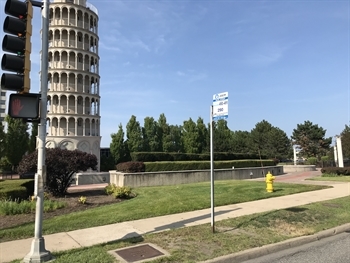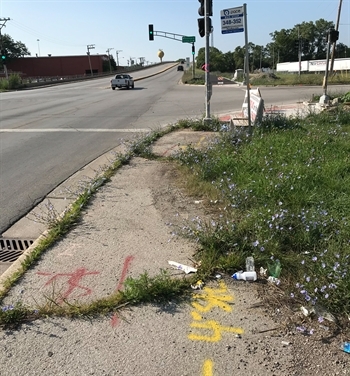For people with disabilities, each leg of one's journey must be accessible, just as each link in a chain must remain unbroken. Our region is blessed with a robust network of fixed-route transit, but too often, the first or last 500 feet of a trip prevent people with disabilities from commuting via bus or train.

Sometimes something isn’t better than nothing. (York Road in Oakbrook, Pace Route 301)
Every one of us will experience a disability, temporary or permanent, at some point in our lives, either personally or as a caregiver. The mobility that we take for granted can change in the blink of an eye. I can attest to that. Last year I took an unfortunate tumble that left me needing knee surgery. Recovery was long. I spent nearly two months on crutches and had six months of physical therapy. I was so lucky to have the support of family and friends who helped me get around. For the first few weeks when my mobility was most impacted, my wife drove me from Logan Square to MPC’s office in the Loop before heading down to her office in Hyde Park.
As you can imagine, fighting rush hour traffic in multiple directions was not sustainable. Eventually, I took the leap back to my normal transit commute: the 73 bus to the Blue Line. I won’t lie, taking transit with a leg brace wasn’t fun. You wouldn’t believe how often I was left standing, gripping a handhold in one hand and juggling my crutches in the other. But putting rider etiquette aside, the trip was possible. The CTA’s kneeling buses allowed me to board from the curb without having to step up, and I was lucky to have elevators at the ‘L’ stations I used. Most importantly, Chicago’s complete network of sidewalks and curb ramps let me make my way safely to the bus stop and train station. After all, having accessible public transit isn’t much good if you can’t get to it.
This experience got me thinking. All of CTA and Pace’s buses have accessibility features like wheelchair lifts and audible announcements. But how does the surrounding built environment impact the ability for people with disabilities to actually reach, and therefore use, the fixed-route transit system? We decided to do a little field work to find out. We picked three Pace bus routes and surveyed all the stops traveling in one direction along the route – roughly 50% of the total stops.
|
Route
|
Description
|
Stops Surveyed
|
|
290
|
Touhy Avenue from Park Ridge to Rogers Park, Chicago
|
67
|
|
301
|
Roosevelt Road from Wheaton to Forest Park
|
82
|
|
352
|
Halsted Street from 95th Street to Chicago Heights
|
58
|
We looked for seven different characteristics that are important to all riders, but especially important to people with disabilities. We wanted to answer the questions: if somebody with a mobility impairment wanted to take the bus, could they even do it? Could they reach the stop safely? How about comfortably?
Sidewalks: The most basic ingredient for accessibility is a sidewalk. We looked to see if there were sidewalks leading to the stop in both directions. Sidewalks that ended after only a short distance didn't count. You might be surprised at how common these sidewalks-to-nowhere are. While we certainly understand the fiscal reality of incremental improvement, it doesn't help the user much.
This stop will give you some protection from the elements, but how do you reach it? (Halsted & 145th, Rte 352)

It’s not unusual to see stops where the rider would have to negotiate uneven ground to get from the sidewalk to the bus. (6300 Touhy Ave, Niles, Pace Route 290)
Curb Access: We checked to see if there was paved access to the curb itself where the rider would board the bus. In many suburban contexts, there’s a grassy median between the sidewalk and curb that would be very difficult to navigate for somebody using a mobility aid. This uneven ground is also very hazardous for people with low vision.
Curb Ramps: Curb ramps that gently slope from the sidewalk to the street crossing are absolutely essential for people using wheelchairs. Otherwise, they get caught in the street. We checked for ramps at all the intersections adjacent to the stop.

No safe route across this 5-lane “stroad” at Roosevelt and 2nd Street. What happens if your destination is on the other side? (Pace Route 301)
Crosswalks: Many times, your destination is actually on the other side of the street from where you get off the bus. We looked for marked crosswalks at all intersections near the bus stop. Most stops have crosswalks across small cross streets adjacent to the bus stop, but many are missing safe crossings across the large arterials common in the suburbs. A 5-lane road with no crosswalk and no pedestrian signal may as well be a brick wall.

Target shoppers would surely appreciate a shelter to protect their newly acquired wares. (Touhy Ave & Melvina, Pace Route 290)
Bus Shelter: Delivering bus service in the suburbs is not an easy task, and Pace does an amazing job serving areas that were never designed with transit in mind. But buses may only come every 30 to 60 minutes, meaning longer waits are not uncommon. Having a sheltered waiting area can make a huge difference for people making the choice between fixed-route transit or a door-to-door paratransit service.

This might technically be a sidewalk, but it’s not safe to use for many people. (Halsted and Jackson, Rte 352)
Seating: Many disabilities are invisible, outwardly manifesting only as fatigue and pain. For these riders, having somewhere to rest while waiting is critical.
Free from obstructions: Sidewalk maintenance is a challenge for many municipalities in the region. This can create unsafe and unpassable areas. We checked to see whether or not the sidewalks were actually usable.
In total, we found that only 7% of the 207 bus stops we surveyed had all of the characteristics we were looking for. Meanwhile, 44% had fewer than three. On some bus routes, that number was higher than 50%. Even the most basic accessibility feature – a sidewalk – was missing from 14% of the stops we looked at. This makes it a challenge for anybody to use the fixed route system. For people with a disability that impacts their mobility, it’s almost impossible.
So what can we do about it?
|
Route
|
% of Stops with Improvements
|
|
Sidewalk
|
Curb Access
|
Curb Ramps
|
Crosswalks
|
Bus Shelter
|
Seating
|
No Obstructions
|
3 or fewer
|
All 7
|
|
290
|
94%
|
64%
|
84%
|
54%
|
10%
|
18%
|
88%
|
31%
|
4%
|
|
301
|
84%
|
56%
|
73%
|
23%
|
12%
|
21%
|
65%
|
51%
|
6%
|
|
352
|
78%
|
57%
|
60%
|
43%
|
36%
|
36%
|
59%
|
50%
|
12%
|
|
Total
|
86%
|
59%
|
73%
|
39%
|
18%
|
24%
|
71%
|
44%
|
7%
|
MPC is working on a report that articulates a vision for universal mobility in the Chicago region. We’re proposing a series of policies and programs to elevate the baseline level of mobility for all people, regardless of age or ability. Several recommendations relate directly to improving the walkability of the region.
- Create a regional ADA accessible pedestrian infrastructure dataset, and a plan to complete the network
Walkability is a regional issue, so we need to create a regional dataset to understand how to move forward. CMAP recently developed the region’s first comprehensive sidewalk dataset, but that’s just the beginning. We need information on crosswalks, curb cuts and pedestrian signals. This data will help us identify where the most critical gaps are.
- Create a technical assistance program to help municipalities complete ADA transition plans
The Americans with Disabilities Act requires most municipalities to create an ADA transition plan that identifies what investments are needed to be compliant with the ADA. Many municipalities in our region do not have plans, or they haven’t been updated in many years. These are not easy plans to develop. They require expertise, time and money. The region needs a technical assistance program to help communities understand what steps they need to take to build an accessible streetscape.
- Eliminate IDOT’s local financial match requirements for sidewalk construction
IDOT requires a 20% local match for sidewalk projects built under their Complete Streets policy. This is a significant barrier to many communities.